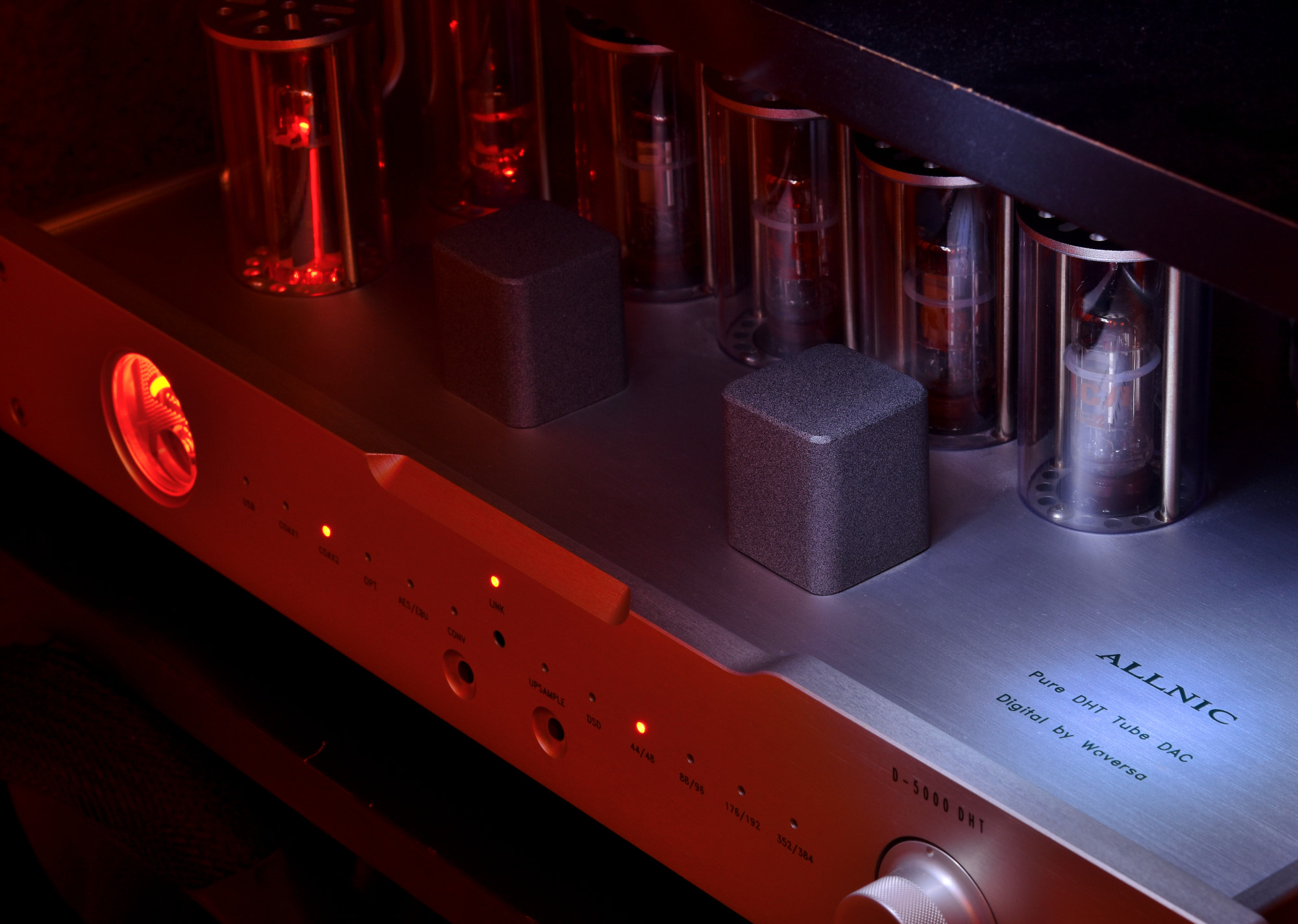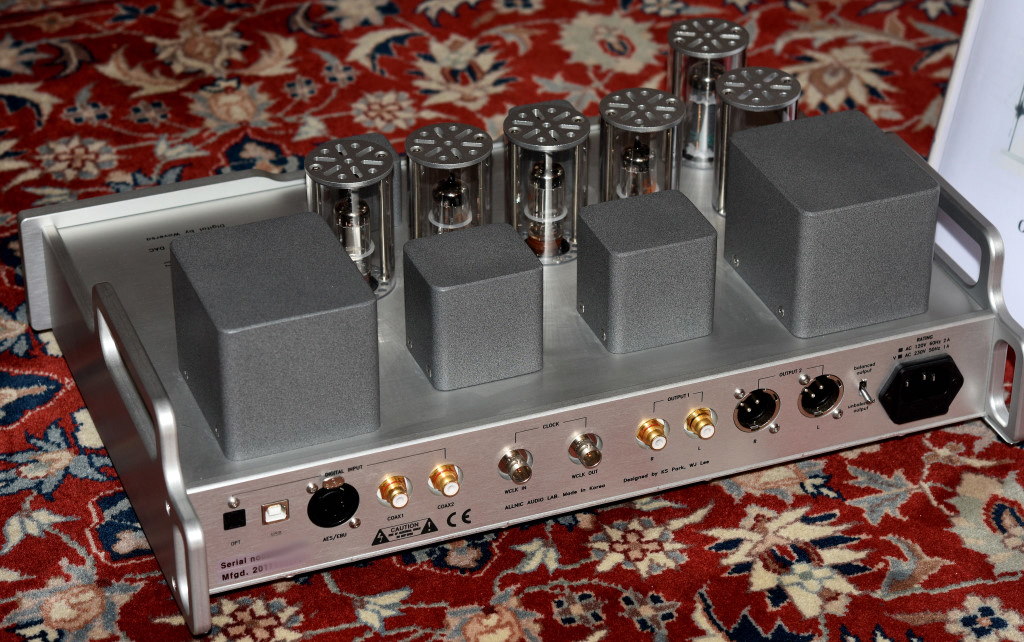
A brief review of the ALLNIC D5000 dht DAC converter
What happens when the cold digital meets warm tubes?
|
|
|
A brief review of the ALLNIC D5000 dht DAC converter |
Recently I had the opportunity to buy a used ALLNIC D5000 DAC,a digital-to-analog converter able to do upsampling and real-time DSD conversion, that uses 3A5 Direct Heathed Tube (DHT) as output devices. You can find in Internet already many review of it, including some very nasty comments, that mainly originates from a bad measurement section in the review published years ago by Stereophile. For that reason I was quite curious to understand how the same device could collect so many different opinions (most of which were really enthusiastic).
 The back side of the ALLNIC D5000 DAC: there are many inputs, including also USB |
|
|
|
|
The first time that I heard it there was some residual 50 Hz noise in the output that you can easily hear going near the loudspeakers. Even so, the sound was quite rich and detailed, so I did not despair and brought it in my personal lab. After few tests it was quite clear that my unit had four bad 3A5 output tubes, with two of them being almost exhausted.
I asked to Allnic to buy a replacement and they (Mr Kang Su Park) sent me a free replacement. With the replaced 3A5 tubes the output noise disappeared and total harmonic distortion (THD) improved of at least 10 dB for each channel.
|
|
|
Then I started to enjoy it and... I enjoyed it so much that I feel the need to write this review, even if I stopped to write in my audio blog many years ago (because I dedicated all my time to my own audio projects). In fact, this DAC sounds so well, so analogue, that I had to tell it to everyone: This DAC has huge soundstage, incredible details and realistic bass!
|
|
|
|
Effectively THD was relatively high. For comparison I report here a few measurements of the first 9 harmonics (THD) that I have collected at 5kHz with my Rohde & Schwarz (note that usualy THD is worse -higher numbers- when the signal output increases):
|
Digital player/DAC |
V output [V rms] |
THD [dB] |
|
TEA DAC (Zvok ESS 9023) |
0.6 |
-96 |
|
TEA DAC (Zvok ESS 9023) |
1.1 |
-94 |
|
Faber's Cable DAC OPA (Buffalo ES9018) |
0.7 |
-94 |
|
Faber's Cable DAC OPA (Buffalo ES9018) |
1.3 |
-92 |
|
Conrad Johnson DV2b (TDA1305) good tubes |
0.8 |
-81 |
|
Conrad Johnson DV2b (TDA1305) good tubes |
1.4 |
-76 |
|
Conrad Johnson DV2b (TDA1305) very used tubes |
0.8 |
-77 |
|
Conrad Johnson DV2b (TDA1305) very used tubes |
1.4 |
-71 |
|
Sonic Frontiers SFD-1 MkII (UltraAnalogue) |
0.6 |
-82 |
|
CEC TL51XR (BB PCM 1796) |
0.6 |
-81 |
|
CEC TL51XR (BB PCM 1796) |
1.1 |
-79 |
|
Allnic D5000 dht (2x ES9018) |
0.3 |
-72 |
|
Allnic D5000 dht (2x ES9018) |
1.0 |
-68 |
|
Sony XA5400ES with TEA output (BB DSD1796) |
0.5 |
-68 |
|
Sony XA5400ES with TEA output (BB DSD1796) |
1.0 |
-62 |
Let's face it: the D5000 does not have the lowest THD performances and in particular it is far from the Faber's Cable DAC prototype (not on sell), that was probably the best DAC I ever heard in my system (and that has the same DAC chip). But it is the THD really the best way to estimate the value of a DAC? In particular, it would not be possible that below a certain threshold (-60/70 dB?) the distortion is simply not udible by humans? So, what's the point of insisting that a certain new top-of-the-line DAC has THD lower than -120dB, while the loudspeaker of your system have a THD of -50dB or even worse? That's is just marketing!
|
|
|
If that is true, the question is where the secret of the wonderful sound of the D5000 DAC is hidden? One possible answer is the very well designed digital board, developed by the Korean Waversa System company. The DAC conversion is made by two Sabre ES9018 (that has 8 DAC per channel, with the potential of using 16 DAC circuits per channel), but all the digital receiver and filtering is made by the customized Cyclone IV FPGA, while the I/V conversion is made by proprietary Waversa analogue modules. I can hear only the final result, but I suspect that the digital recipy implemented by Waversa is really wonderful and the Allnic analogue output, implemented with triodes and transformers, gives just the needed touch to make the analogue output... sounding even more analogue!
Note that my measurement and sounding impressions were all based on compact discs played by a CEC TL51XR transport in a "Red Book" world, i.e. without any UPSAMPLING or DSD CONVERSION (two digital options implemented in this DAC).

From what I can uderstand the D5000 DAC is no more in production, probably also because of that review, where relatively bad measurements were found, but in that case I'm not sure if the 3A5 tubes were in perfect condition, when that unit was measured.
I'm a technician and I was also oriented to believe that better THD means better sound, but after hearing how good this damn DAC sounds I had to rethink my approach! Thus, I can only suggest you to give it a try, if you can find it, and to check the 3A5 now and then, to replace them when THD raise in the -50dB range. Luckily, 3A5 DHT are at least 10 times cheaper than their cousin 2A3.
Now that my system has being raised to a new level by this DAC I know that I can hear also components with about -70dB of THD and that I can really enjoy them... sooo much!
Thanks Allnic for producing such a magically-musical instrument!
|
|
|
© Tino March 2020